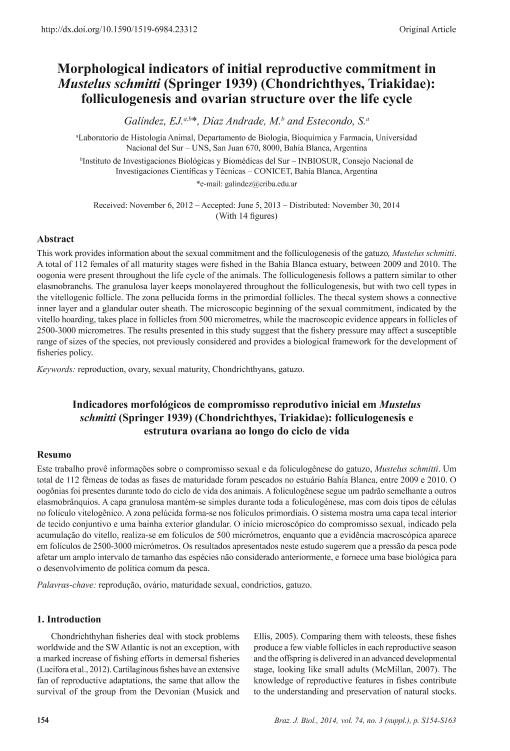Mostrar el registro sencillo del ítem
dc.contributor.author
Galíndez, Elena Juana

dc.contributor.author
Díaz Andrade, María Constanza

dc.contributor.author
Estecondo, Silvia

dc.date.available
2020-04-03T22:27:28Z
dc.date.issued
2014-08
dc.identifier.citation
Galíndez, Elena Juana; Díaz Andrade, María Constanza; Estecondo, Silvia; Morfological indicators of initial reproductive commitment in Mustelus schmitti (Chondrichthyes, Triakidae): folliculogenesis and ovarian structure along the life cycle; Instituto Internacional de Ecología; Brazilian Journal of Biology; 74; 3; 8-2014; 154-163
dc.identifier.issn
1519-6984
dc.identifier.uri
http://hdl.handle.net/11336/101989
dc.description.abstract
This work provides information about the sexual commitment and the folliculogenesis of the gatuzo, Mustelus schmitti. A total of 112 females of all maturity stages were fished in the Bahía Blanca estuary, between 2009 and 2010. The oogonia were present all along the life cycle of the animals. The folliculogenesis follows a pattern similar to other elasmobranchs. The granulosa layer keeps monolayered throughout the folliculogenesis, but with two cell types in the vitellogenic follicle. The zona pellucida forms in the primordial follicles. The thecal system shows a connective inner layer and a glandular outer sheath. The microscopic beginning of the sexual commitment, indicated by the vitello hoarding, takes place in follicles from 500 micrometers, while the macroscopic evidence appears in follicles of 2500-3000 micrometers. The results presented in this study suggest that the fishery pressure may affect a susceptible range of sizes of the species, not previously considered and provides a biological framework for the development of fisheries police.
dc.description.abstract
Este trabalho provê informações sobre o compromisso sexual e da foliculogênese do gatuzo, Mustelus schmitti. Um total de 112 fêmeas de todas as fases de maturidade foram pescados no estuário Bahía Blanca, entre 2009 e 2010. O oogônias foi presentes durante todo do ciclo de vida dos animais. A foliculogênese segue um padrão semelhante a outros elasmobrânquios. A capa granulosa mantém-se simples durante toda a foliculogénese, mas com dois tipos de células no folículo vitelogênico. A zona pelúcida forma-se nos folículos primordiais. O sistema mostra uma capa tecal interior de tecido conjuntivo e uma bainha exterior glandular. O início microscópico do compromisso sexual, indicado pela acumulação do vitello, realiza-se em folículos de 500 micrómetros, enquanto que a evidência macroscópica aparece em folículos de 2500-3000 micrómetros. Os resultados apresentados neste estudo sugerem que a pressão da pesca pode afetar um amplo intervalo de tamanho das espécies não considerado anteriormente, e fornece uma base biológica para o desenvolvimento de política comum da pesca.
dc.format
application/pdf
dc.language.iso
eng
dc.publisher
Instituto Internacional de Ecología

dc.rights
info:eu-repo/semantics/openAccess
dc.rights.uri
https://creativecommons.org/licenses/by-nc-sa/2.5/ar/
dc.subject
REPRODUCTION
dc.subject
OVARY
dc.subject
SEXUAL MATURITY
dc.subject
CHONDRICHTHYANS
dc.subject.classification
Biología Reproductiva

dc.subject.classification
Ciencias Biológicas

dc.subject.classification
CIENCIAS NATURALES Y EXACTAS

dc.title
Morfological indicators of initial reproductive commitment in Mustelus schmitti (Chondrichthyes, Triakidae): folliculogenesis and ovarian structure along the life cycle
dc.title
Indicadores morfológicos de compromisso reprodutivo inicial em Mustelus schmitti (Springer 1939) (Chondrichthyes, Triakidae): folliculogenesis e estrutura ovariana ao longo do ciclo de vida
dc.type
info:eu-repo/semantics/article
dc.type
info:ar-repo/semantics/artículo
dc.type
info:eu-repo/semantics/publishedVersion
dc.date.updated
2020-04-02T13:53:18Z
dc.identifier.eissn
1678-4375
dc.journal.volume
74
dc.journal.number
3
dc.journal.pagination
154-163
dc.journal.pais
Brasil

dc.journal.ciudad
Sao Carlos
dc.description.fil
Fil: Galíndez, Elena Juana. Universidad Nacional del Sur. Departamento de Biología, Bioquímica y Farmacia; Argentina
dc.description.fil
Fil: Díaz Andrade, María Constanza. Consejo Nacional de Investigaciones Científicas y Técnicas. Centro Científico Tecnológico Conicet - Bahía Blanca. Instituto de Ciencias Biológicas y Biomédicas del Sur. Universidad Nacional del Sur. Departamento de Biología, Bioquímica y Farmacia. Instituto de Ciencias Biológicas y Biomédicas del Sur; Argentina
dc.description.fil
Fil: Estecondo, Silvia. Universidad Nacional del Sur. Departamento de Biología, Bioquímica y Farmacia; Argentina
dc.journal.title
Brazilian Journal of Biology

dc.relation.alternativeid
info:eu-repo/semantics/altIdentifier/url/http://www.scielo.br/scielo.php?script=sci_arttext&pid=S1519-69842014003000021
dc.relation.alternativeid
info:eu-repo/semantics/altIdentifier/url/http://www.scielo.br/pdf/bjb/v74n3s1/1519-6984-bjb-74-03s1-S154.pdf
dc.relation.alternativeid
info:eu-repo/semantics/altIdentifier/doi/http://dx.doi.org/10.1590/1519-6984.23312
Archivos asociados
